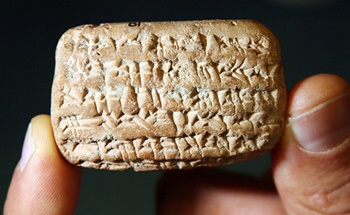Print Article
Author's Bias | Interpretation: conservative | Inclination: promise | Seminary: none
Excavating the ancient Babylonian city of Sippar (Tell Abu Habbah) during 1880 – 1882, Assyriologist Hormuzd
Rassam recovered nearly 130,000 inscribed tablets and fragments, which are presently housed for study at the
British Museum.

This clay tablet is less than 2.5 inches!
© Biblearchaeology.org
In 2007, Assyriologist Michael Jursa published his work deciphering a tiny Akkadian cuneiform inscribed tablet
from this collection. He discovered that it was a record of a donation of gold by an official named Nabu-sharrussu-ukin
to the Temple of Esangila located in Babylon during the reign of Nebuchadnezzar.
[Regarding] 1.5 minas (0.75 kg) of gold, the property of Nabu-sharrussu-ukin, the chief
eunuch, which he sent via Arad-Banitu the eunuch to [the temple] Esangila: Arad-Banitu has delivered [it] to
Esangila. In the presence of Bel-usat, son of Alpaya, the royal bodyguard, [and of] Nadin, son of Marduk-zer-ibni.
Month XI, day 18, year 10 [of] Nebuchadnezzar, king of Babylon.
Dated to 595 B.C., this tablet is significant to biblical scholars for two reasons:
Donation date of "year 10 of Nebuchadnezzar"
The date explicitly establishes when the tablet was made which was during the reign of
Nebuchadnezzar II (reign 605 – 562 B.C.). Just a little earlier in 597 B.C., Nebuchadnezzar attacks Judah and takes
Jerusalem in response to the rebellion of Jehoakim and Jehoiachin. Approximately 10,000 captives were deported
including the prophet Ezekiel (Ezek 1:1-3;
2 Ki 24:8-20; 2 Chron 36:6-10).
"Nabu-sharrussu-ukin the chief eunuch"
The Akkadian name Nabu-sharrussu-ukin, phonetically Nebo-Sarsekim, was equivalent to the Hebrew
name Sar-sekim, and to this name, the Bible attached the title "the Rab-saris," which meant "chief eunuch."
Then all the officials of the king of Babylon came in and sat down at the Middle Gate:
Nergal-sar-ezer, Samgar-nebu, Sar-sekim the Rab-saris, Nergal-sar-ezer the Rab-mag, and all the rest of the officials
of the king of Babylon. (Jer 39:3)
Eunuchs were common in Assyrian and Neo-Babylonian courts, and there were several with the title
of "chief eunuch" functioning as officials for the king (2 Ki 18:17;
Jer 39:13).
The Bible refers to Nebo-Sarsekim only once and approximately 9 years after the Nebo-Sarsekim
tablet. Jeremiah’s account referred to 586 B.C., when Nebuchadnezzer, in response to the rebellion of Zedekiah,
destroyed Jerusalem, the Temple and many Jews. Of the surviving Jews, numerous were deported to Babylon
(2 Ki 25:1-7; Jer 34:1-7;
39:1-7; 52:2-11).
The work of Hormuzd Rassam and Michael Jursa is significant in providing further evidence for the historicity
of the Bible and specifically the record of Jeremiah. It is remarkable that a single tiny tablet (less than 2.5
inches in length) has survived 2700 years to reveal the name and title of a Neo-Babylonian court official who
the Bible mentions only once with the same name and title of the same period.
References:
1. Wood BG, "Nebo Sarsekim found in Babylonian Tablet" in Bible and Spade (Summer, 2007).
2. Gaeblein FE ed., The Expositor's Bible Commentary, vol. 6, Grand Rapids: Zondervan Publishing House (1992).
Copyright ©
2018
Helpmewithbiblestudy.org. All rights to this material are reserved. We encourage you to print the material for personal and
non-profit use or link to this site. If you find this article to be a blessing, please share the link so that it may rise in
search engine rankings.